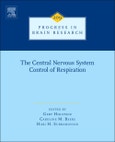Respiration is one of the most basic motor activities crucial for survival of the individual. It is under total control of the central nervous system, which adjusts respiratory depth and frequency depending on the circumstances the individual finds itself. For this reason this volume not only reviews the basic control systems of respiration, located in the caudal brainstem, but also the higher brain regions, that change depth and frequency of respiration. Scientific knowledge of these systems is crucial for understanding the problems in the many patients suffering from respiratory failure.
Table of Contents
Rhythmic Bursting in the Pre-Bötzinger Complex: Mechanisms and Models Effects of Glycinergic Inhibition Failure on Respiratory Rhythm and Pattern Generation Morphological Characterization of Respiratory Neurons in the pre-Bötzinger Complex Cytoarchitecture and CO2 Sensitivity of Phox2b-Positive Parafacial Neurons in the Newborn Rat Medulla Contributions of the pre-Bötzinger Complex and the Kölliker-Fuse Nuclei to Respiratory Rhythm and Pattern Generation in Awake and Sleeping The Integrative Role of the Sigh in Psychology, Physiology, Pathology and Neurobiology Mechanism of Sympathetic Activation and Blood Pressure Elevation in Humans and Animals following Acute Intermittent Hypoxia Effect of Chronic Intermittent Hypoxia on the Reflex Recruitment of the Genioglossus during Airway Obstruction in the Anaesthetized Rat Peptides, Serotonin and Breathing: The Role of the Raphe in the Control of Respiration Cardiorespiratory Coupling: Common Rhythms in Cardiac, Sympathetic and Respiratory Activities Serotonin Neurons and Central Respiratory Chemoreception: Where are we now? Bidirectional Plasticity of Pontine Pneumotaxic Post-Inspiratory Drive: Implication for a Pontomedullary Respiratory Central Pattern Generator Sleep-Wake Control of the Upper Airway by Noradrenergic Neurons, with and without Intermittent Hypoxia Affective Brain Areas and Sleep Disordered Breathing The Neural Control of Human Inspiratory Muscles Convergence of Pattern Generator Outputs on a Common Mechanism of Diaphragm Motor Unit Recruitment The Peripheral Actions of the Central Neuropeptide Somatostatin on Control of Breathing: Effect on Metabolic Rate and Chemoreflex Responses in Humans Control of Blood Pressure, Micturition and Respiration via the Human Brain using Neurosurgery Where is the Rhythm Generator for Emotional Breathing? The Periaqueductal Gray Controls Brainstem Emotional Motor Systems Including Respiration








